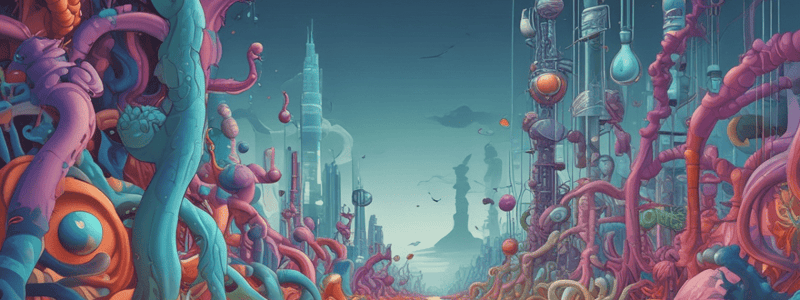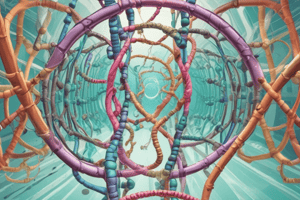Podcast
Questions and Answers
What is the primary focus of White Biotechnology?
What is the primary focus of White Biotechnology?
- Genetic engineering of plants
- Production of chemicals/materials from renewable resources (correct)
- Marine and aquatic applications of biotechnology
- Medical and pharmaceutical biotechnology
What are the products of biotechnology that are genetically modified?
What are the products of biotechnology that are genetically modified?
- Pharmaceutical and medicinal products
- Agricultural products (correct)
- Industrial raw materials
- Bio-hazard weapons
What is the term for the production of chemicals/materials from renewable resources in biotechnology?
What is the term for the production of chemicals/materials from renewable resources in biotechnology?
- Cloning
- Genetic engineering
- Bio-catalysis (correct)
- Polymerase Chain Reaction (PCR)
What is the application of biotechnology that involves the genetic engineering of plants?
What is the application of biotechnology that involves the genetic engineering of plants?
What is the term for the area of biotechnology that involves marine and aquatic applications?
What is the term for the area of biotechnology that involves marine and aquatic applications?
What is the technique used in biotechnology that involves the cutting and joining of DNA molecules?
What is the technique used in biotechnology that involves the cutting and joining of DNA molecules?
What is the focus of Red Biotechnology?
What is the focus of Red Biotechnology?
What is the term for the products that are produced through the application of biotechnology?
What is the term for the products that are produced through the application of biotechnology?
What is the technique used in biotechnology that involves the amplification of DNA sequences?
What is the technique used in biotechnology that involves the amplification of DNA sequences?
What is the primary focus of Grey biotechnology?
What is the primary focus of Grey biotechnology?
What is the primary application of Bioremediation?
What is the primary application of Bioremediation?
What is the primary focus of Gold biotechnology?
What is the primary focus of Gold biotechnology?
What is the primary application of Modern Biotechnology?
What is the primary application of Modern Biotechnology?
What is the primary focus of Pharmaceutical Biotechnology?
What is the primary focus of Pharmaceutical Biotechnology?
What is the primary application of Microbial Biotechnology?
What is the primary application of Microbial Biotechnology?
What is the primary focus of Forensic Biotechnology?
What is the primary focus of Forensic Biotechnology?
What percentage of biotechnology products are geared toward cancer therapy?
What percentage of biotechnology products are geared toward cancer therapy?
How many biotechnology products were developed by pharmaceutical companies in the last decade?
How many biotechnology products were developed by pharmaceutical companies in the last decade?
What ancient practice has been used to preserve food?
What ancient practice has been used to preserve food?
Who is credited with pioneering a food preservation method involving heat?
Who is credited with pioneering a food preservation method involving heat?
What is a benefit of biotechnology in terms of waste management?
What is a benefit of biotechnology in terms of waste management?
What is a potential long-term consequence of biotechnology on croplands?
What is a potential long-term consequence of biotechnology on croplands?
What is the primary purpose of recombinant DNA technology?
What is the primary purpose of recombinant DNA technology?
What is a potential drawback of biotechnology?
What is a potential drawback of biotechnology?
What is a potential weaponization of biotechnology?
What is a potential weaponization of biotechnology?
What is a concern related to biotechnology and human health?
What is a concern related to biotechnology and human health?
What is an example of how biotechnology has helped with disease?
What is an example of how biotechnology has helped with disease?
What type of enzyme is responsible for removing nucleotides from the end of DNA?
What type of enzyme is responsible for removing nucleotides from the end of DNA?
What is a potential social consequence of unregulated biotechnology?
What is a potential social consequence of unregulated biotechnology?
What is a consequence of biotechnology's all-or-nothing approach?
What is a consequence of biotechnology's all-or-nothing approach?
What is a long-term unknown of biotechnology related to the environment?
What is a long-term unknown of biotechnology related to the environment?
What is the primary function of ligases in recombinant DNA technology?
What is the primary function of ligases in recombinant DNA technology?
What is a benefit of biotechnology in terms of protecting vulnerable populations?
What is a benefit of biotechnology in terms of protecting vulnerable populations?
What is a potential environmental consequence of biotechnology?
What is a potential environmental consequence of biotechnology?
What type of enzyme is responsible for cutting DNA at specific positions?
What type of enzyme is responsible for cutting DNA at specific positions?
What is a potential benefit of biotechnology on food production?
What is a potential benefit of biotechnology on food production?
What is the term used to describe the DNA molecule that carries a foreign DNA fragment into a host organism?
What is the term used to describe the DNA molecule that carries a foreign DNA fragment into a host organism?
Which type of restriction endonuclease requires ATP to cut DNA and cuts about 1000bp away from its restriction site?
Which type of restriction endonuclease requires ATP to cut DNA and cuts about 1000bp away from its restriction site?
What is the purpose of terminal transferase in recombinant DNA technology?
What is the purpose of terminal transferase in recombinant DNA technology?
What is the name of the enzyme isolated from E. coli infected with a lytic Bacteriophage T4?
What is the name of the enzyme isolated from E. coli infected with a lytic Bacteriophage T4?
What is the term used to describe the DNA fragment being transferred into another organism?
What is the term used to describe the DNA fragment being transferred into another organism?
Which enzyme is used to synthesize complementary strand (cDNA) from mRNA template?
Which enzyme is used to synthesize complementary strand (cDNA) from mRNA template?
What is the type of restriction endonuclease that does not require ATP to cut DNA and cuts at the restriction site itself?
What is the type of restriction endonuclease that does not require ATP to cut DNA and cuts at the restriction site itself?
What is the purpose of DNA ligase in recombinant DNA technology?
What is the purpose of DNA ligase in recombinant DNA technology?
What is the source of reverse transcriptase?
What is the source of reverse transcriptase?
Flashcards are hidden until you start studying
Study Notes
Introduction to Biotechnology
- Biotechnology involves the use of biological systems, living organisms, or derivatives thereof, to make or modify products for specific use
- Products of biotechnology range from agricultural products (genetically modified foods), pharmaceutical and medicinal products (vaccines and monoclonal antibodies), industrial raw materials (synthetic raw materials), and military products (bio-hazard weapons)
Areas of Biotechnology
- White Biotechnology: Industrial Biotechnology, primarily bio-catalysis and the production of chemicals/materials from renewable resources, as well as (hazardous) waste treatment
- Red Biotechnology: Medical and pharmaceutical biotechnology
- Green Biotechnology: Agricultural biotechnology, primarily genetic engineering of plants
- Blue Biotechnology: Marine and aquatic applications of biotechnology, e.g. fish farming and algae cultivation
- Grey Biotechnology: Conservation and restoration of contaminated natural ecosystems
- Gold Biotechnology: Also known as bioinformatics; responsible for obtaining, storing, analyzing, and separating biological information, especially that related to DNA and amino acid sequences
Timeline of Biotechnology
- Ancient Biotechnology: Early history as related to food and shelter, includes domestication
- Classical Biotechnology: Built on ancient biotechnology; fermentation promoted food production and medicine
- Modern Biotechnology: Manipulates genetic information in organisms, genetic engineering
Types and Applications of Biotechnology
- Microbial Biotechnology
- Agricultural Biotechnology
- Animal Biotechnology
- Forensic Biotechnology
- Bioremediation
- Aquatic Biotechnology
- Medical Biotechnology
- Pharmaceutical Biotechnology
Pharmaceutical Biotechnology
- Biopharmaceutical drugs generated through researches in cell biology, genetics, and recombinant DNA technology
- Recombinant DNA (rDNA) and monoclonal antibody (mAb) provide exciting opportunities for new pharmaceuticals development as well as new approaches to drug delivery
Advantages of Biotechnology
- Allows us to create waste products with better biodegradable properties
- Helps us minimize or eliminate waste products
- Enables us to manage landfills more effectively
- Reduces infectious disease rates
- Helps us create vaccines and treatments that reduce difficult symptoms of disease
Cons of Biotechnology
- Creates an all-or-nothing approach
- Lack of genetic diversity due to processes that increase crop yields and improve medical science
- Field of research with many unknowns
- Can ruin croplands and reduce their viability
- Can be used for destruction, e.g., weaponizing crops and diseases
Basic Tools and Techniques Used in Biotechnology
- Recombinant DNA Technology (RDT, Genetic Engineering)
- Enzymes: cleaving enzymes, synthesizing enzymes, joining enzymes, alkaline phosphatases
- Vector or Vehicle DNA: plasmids, bacteriophage DNA, cosmid, phagemid/phasmid, artificial chromosome vectors
- Passenger DNA: complementary DNA- cDNA, Synthetic DNA- sDNA, random DNA
Enzymes Used in Recombinant DNA Technology
- DNA ligase: joins DNA fragments with cloning vector
- Reverse transcriptase: synthesizes complementary strand (cDNA) from mRNA template
- Restriction endonuclease: recognizes and cuts DNA strand at specific sequence called restriction site
- Terminal transferase: converts blunt end of DNA fragments into sticky end
- DNA polymerase: synthesizes new DNA strand
Studying That Suits You
Use AI to generate personalized quizzes and flashcards to suit your learning preferences.





